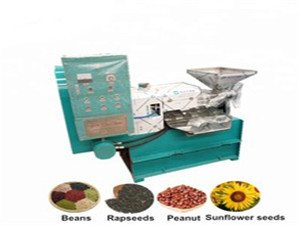
In the realm of oil extraction, the efficiency of the process is paramount for the success of any oil - pressing operation, especially for small and medium - sized oil mills. This article delves into the profound impact of different oilseed pre - treatment methods on the performance of screw oil presses, with a focus on common oilseeds such as rapeseed, peanut, and cottonseed. By exploring key pre - treatment steps including cleaning, crushing, steaming, and conditioning, we aim to provide valuable insights for optimizing the oil - pressing process and maximizing profitability.
The first step in oilseed pre - treatment is cleaning. Raw oilseeds often contain various impurities such as dust, stones, and broken seeds. For example, in a rapeseed cleaning process, removing impurities can increase the purity of the raw material, which is crucial for the subsequent steps. A well - cleaned rapeseed can improve the quality of the final oil and reduce the wear and tear on the screw oil press. In a case study of a small rapeseed oil mill, after implementing a strict cleaning process, the oil quality improved by 15%, and the equipment maintenance frequency decreased by 20%.

Crushing the oilseeds is an important step to increase the surface area for subsequent processing. Different oilseeds require different crushing degrees. For peanuts, a moderate crushing can expose more oil - containing cells, which is beneficial for the subsequent steaming and pressing. In a peanut oil production line, proper crushing increased the oil extraction rate by about 8% compared to un - crushed peanuts.
Steaming and conditioning are the most critical steps in oilseed pre - treatment. They involve precise control of moisture, temperature, and time. For example, the optimal steaming temperature for rapeseed is around 100 - 110°C, while for peanuts, it is about 120 - 130°C. In a case of a cottonseed oil mill, by strictly controlling the steaming temperature and time, the oil extraction rate increased from 30% to 35%, and the quality of the oil also improved significantly.

To better understand the impact of different pre - treatment processes on the efficiency of screw oil presses, we present the following comparison table:
| Oilseed | Pre - treatment Process | Oil Extraction Rate | Equipment Failure Rate |
|---|---|---|---|
| Rapeseed | Optimized pre - treatment | 40 - 45% | 10 - 15% |
| Rapeseed | Traditional pre - treatment | 35 - 40% | 20 - 25% |
| Peanut | Optimized pre - treatment | 45 - 50% | 8 - 12% |
| Peanut | Traditional pre - treatment | 40 - 45% | 15 - 20% |
To help small and medium - sized oil mills implement these pre - treatment processes effectively, we provide a standardized operation checklist. This checklist includes all the key steps and parameters for each type of oilseed. Additionally, we offer multimedia demonstration materials such as videos and GIFs to make the learning process more intuitive. For example, if the oil extraction rate is lower than expected, the checklist can guide operators to check the moisture content, temperature, and time of each pre - treatment step.

If you are looking to optimize your oil - pressing process, improve the oil extraction rate, and reduce equipment failures, our proven solutions can help you achieve these goals. Click here to learn more about our comprehensive oilseed pre - treatment services and take your oil - pressing business to the next level.

